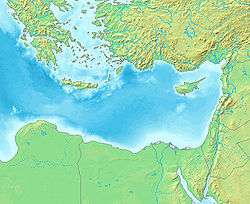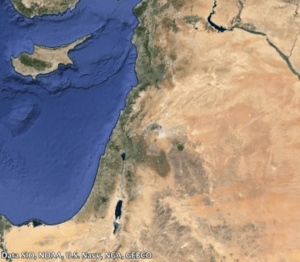Levant
| Levant | |
|---|---|
|
Countries and regions of the Levant in the broad, historic meaning (equivalent to the eastern Mediterranean) [1][2][3] Countries of the Levant in 20th century usage [1]
Countries and regions sometimes included in the modern definition | |
| Countries and regions |
|
| Population | 44,550,926[4] |
| Demonym | Levantine |
| Languages | Levantine Arabic, Hebrew, Aramaic, Armenian, Circassian, Greek, Kurdish, Ladino, Turkish |
| Time Zones | UTC+02:00 (EET) (Turkey and Cyprus) |
The Levant (/ləˈvænt/; Arabic: المشرق /ʔal-maʃriq/[1][5][6][7][8][9][10]) is an approximate historical geographical term referring to a large area in the eastern Mediterranean. In its widest historical sense, the Levant included all of the eastern Mediterranean with its islands,[3] that is, it included all of the countries along the eastern Mediterranean shores, extending from Greece to Cyrenaica.[1][2] The term Levant entered English in the late 15th century from French.[3] It derives from the Italian Levante, meaning "rising", implying the rising of the sun in the east.[1][2] As such, it is broadly equivalent to the Arabic term Mashriq,[5] 'the land where the sun rises'.
In the 13th and 14th centuries, the term levante was used for Italian maritime commerce in the eastern Mediterranean, including Greece, Anatolia, Syria-Palestine, and Egypt, that is, the lands east of Venice.[1] Eventually the term was restricted to the Muslim countries of Syria-Palestine and Egypt.[1] In 1581 England set up the Levant Company to monopolize commerce with the Ottoman Empire.[1]
The name Levant States was used to refer to the French mandate over Syria and Lebanon after World War I.[1][2] This is probably the reason why the term Levant has come to be used synonymously with Syria-Palestine.[1] Some scholars misunderstood the term thinking that it derives from the name of Lebanon.[1] Today the term is typically used in conjunction with prehistoric or ancient historical references. It has the same meaning as Syria-Palestine or the region of Syria (Arabic: الشام /ʔaʃ-ʃaːm/), that is, it means an area bounded by the Taurus Mountains of Turkey in the North, the Mediterranean Sea in the west, and the north Arabian Desert and Mesopotamia in the east.[11] It does not include Anatolia (the former Asia Minor, now Asian Turkey; although at times Cilicia may be included), the Caucasus Mountains, or any part of the Arabian Peninsula proper. The Sinai Peninsula (Asian Egypt) is sometimes included, though more considered an intermediate, peripheral or marginal area forming a land bridge between the Levant and northern African Egypt.
The Levant has been described as the "crossroads of western Asia, the eastern Mediterranean and northeast Africa",[12] and the "northwest of the Arabian plate".[13]
Etymology

The term Levant, which appeared in English in 1497, originally meant the East in general or "Mediterranean lands east of Italy".[14] It is borrowed from the French levant 'rising', referring to the rising of the sun in the east,[14] or the point where the sun rises.[15] The phrase is ultimately from the Latin word levare, meaning 'lift, raise'. Similar etymologies are found in Greek Ἀνατολή (Anatolē, cf. Anatolia), in Germanic Morgenland (literally, "morning land"), in Italian (as in "Riviera di Levante", the portion of the Liguria coast east of Genoa), in Hungarian Kelet, in Spanish and Catalan Levante and Llevant, ("the place of rising"), and in Hebrew (mizrah). Most notably, "Orient" and its Latin source oriens meaning "east", is literally "rising", deriving from Latin orior "rise".[16]

The notion of the Levant has undergone a dynamic process of historical evolution in usage, meaning, and understanding. While the term "Levantine" originally referred to the European residents of the eastern Mediterranean region, it later came to refer to regional "native" and "minority" groups.[17]
The term became current in English in the 16th century, along with the first English merchant adventurers in the region; English ships appeared in the Mediterranean in the 1570s, and the English merchant company signed its agreement ("capitulations") with the Ottoman Sultan in 1579 (Braudel). The English Levant Company was founded in 1581 to trade with the Ottoman Empire, and in 1670 the French Compagnie du Levant was founded for the same purpose. At this time, the Far East was known as the "Upper Levant".[1]
In early 19th-century travel writing, the term sometimes incorporated certain Mediterranean provinces of the Ottoman empire, as well as independent Greece (and especially the Greek islands). In 19th-century archaeology, it referred to overlapping cultures in this region during and after prehistoric times, intending to reference the place instead of any one culture. The French mandate of Syria and Lebanon (1920–1946) was called the Levant states.[1][2]
Geography and modern-day use of the term
Today, "Levant" is the term typically used by archaeologists and historians with reference to the history of the region. Scholars have adopted the term Levant to identify the region due to it being a "wider, yet relevant, cultural corpus" that does not have the "political overtones" of Syria-Palestine.[18][19] The term is also occasionally employed to refer to modern events, peoples, states or parts of states in the same region, namely Cyprus, Egypt, Iraq, Israel, Jordan, Lebanon, Palestine, Syria, and Turkey are sometimes considered Levant countries (compare with Near East, Middle East, Eastern Mediterranean and Western Asia). Several researchers include the island of Cyprus in Levantine studies, including the Council for British Research in the Levant,[20] the UCLA Near Eastern Languages and Cultures department,[21] Journal of Levantine Studies[22] and the UCL Institute of Archaeology,[12] the last of which has dated the connection between Cyprus and mainland Levant to the early Iron Age. Archaeologists seeking a neutral orientation that is neither biblical nor national have used terms such as Syro-Palestinian archaeology and archaeology of the southern Levant.[23][24]
While the usage of the term "Levant" in academia has been restricted to the fields of archeology and literature, there is a recent attempt to reclaim the notion of the Levant as a category of analysis in political and social sciences. Two academic journals were recently launched: Journal of Levantine Studies, published by the Van Leer Jerusalem Institute and The Levantine Review, published by Boston College.
ISIL has adopted the term "Levant" within the English translation of their self-designation.
History
People, politics, religion, and culture
The populations of the Levant[25][26][27] share not only the geographic position, but cuisine, some customs, and a very long history. The largest religious group in the Levant are the Muslims and the largest cultural-linguistic group are primarily Arab, due to the Muslim conquest of the Levant in the 7th century and subsequent Arabization of the region, but there are also many other groups.
The majority of Levantines are Sunni, Salafi, nondenominational or Shia Muslim. There are also Jews, Christians, Yazidi Kurds, Alawites, Nizari, Druze, and Ismailis.
Until the creation of the modern State of Israel in 1948, Jews lived throughout the Levant alongside Muslims and Christians; since then, almost all have been expelled from their homes and sought refuge in Israel.
There are many Levantine Christian groups such as Greek and Oriental Orthodox, Maronite, Roman Catholic, and Protestant. Armenians mostly belong to the Armenian Apostolic Church. There are Levantines or Franco-Levantines who are mostly Roman Catholic. There are also Circassians, Turks, Samaritans, and Nawars. There are Assyrian peoples belonging to the Assyrian Church of the East (autonomous) and the Chaldean Catholic Church (Catholic).
Language
Most Levantine populations speak Levantine Arabic, also known as Mediterranean Arabic (شامي, Šāmī). In Israel, the primary language is Hebrew, while Arabic is also an official language (but de facto a minority language). In Cyprus, the majority language is Greek, followed by Turkish, and then a dialect of Levantine Arabic, Cypriot Maronite Arabic. Some communities and populations speak Aramaic, Greek, Armenian, Circassian, French, English, or other languages in addition to Levantine Arabic.
See also
Overlapping regional designations
Sub-regional designations
Other
- French post offices in the Ottoman Empire ("Levant" stamps)
- History of the Levant
- Islamic State of Iraq and the Levant (Referred to in current events as ISIL or ISIS)
- Levantines (Latin Christians), Catholic Europeans in the Levant
- Levantine Sea
References
- 1 2 3 4 5 6 7 8 9 10 11 12 13 The Oxford Encyclopedia of Ancient Greece and Rome, Volume 1, p247, "Levant"
- 1 2 3 4 5 Microsoft Encarta (2009) "Levant"
- 1 2 3 Oxford Dictionaries Online. "Levant". Oxford University Press. Retrieved 4 April 2015.
- ↑ Population found by adding all the countries' populations (Cyprus, Israel, Jordan, Lebanon, Syria, Palestine and Hatay Province)
- 1 2 Naim, Samia, Dialects of the Levant, in Weninger, Stefan et al. (eds.), The Semitic Languages: An International Handbook, Berlin/Boston: Walter de Gruyter (2011), p. 921
- ↑ Amy Chua (2004), World on Fire: How Exporting Free Market Democracy Breeds Ethnic Hatred and Global Instability p. 212
- ↑ Mandyam Srinivasan, Theodore Stank, Philippe-Pierre Dornier, Kenneth Petersen (2014), Global Supply Chains: Evaluating Regions on an EPIC Framework – Economy, Politics, Infrastructure, and Competence: “EPIC” Structure – Economy, Politics, Infrastructure, and Competence, p. 3
- ↑ Ayubi, Nazih N. (1996), Over-stating the Arab State: Politics and Society in the Middle East p. 108
- ↑ David Thomas, Alexander Mallett (2012), Christian-Muslim Relations. A Bibliographical History. Volume 4 (1200-1350), p. 145
- ↑ Jeff Lesser (1999), Negotiating National Identity: Immigrants, Minorities, and the Struggle for Ethnicity in Brazil p. 45
- ↑ Margreet L. Steiner; Ann E. Killebrew (2014). The Oxford Handbook of the Archaeology of the Levant: C. 8000-332 BCE. OUP Oxford. p. 35. ISBN 978-0-19-921297-2.
The western coastline and the eastern deserts set the boundaries for the Levant... The Euphrates and the area around Jebel el-Bishrī mark the eastern boundary of the northern Levant, as does the Syrian Desert beyond the Anti-Lebanon range's eastern hinterland and Mount Hermon. This boundary continues south in the form of the highlands and eastern desert regions of Transjordan
- 1 2 The Ancient Levant, UCL Institute of Archaeology, May 2008
- ↑ Egyptian Journal of Geology - Volume 42, Issue 1 - Page 263, 1998
- 1 2 Douglas Harper, Online Etymology Dictionary. "Levant". Dictionary.com. Retrieved 2012-07-27.
- ↑ Oxford English Dictionary, 2nd edition
- ↑ Balme, Maurice; Morwood, James. "Chapter 36". Oxford Latin Course Part III (2nd ed.). p. 19.
- ↑ "Journal of Levantine Studies". The Van Leer Jerusalem Institute. Retrieved 30 January 2014.
- ↑ Burke, Aaron. “The Transformation of Biblical and Syro-Palestinian Archaeology." Historical Biblical Archaeology and the Future: The New Pragmatism. Ed. Thomas Evan. Levy. London: Equinox Pub., 2010. “Nevertheless, despite such a well-reasoned basis for the identification of Levantine archaeology, the adoption of this term by many scholars has been, for the most part, simply the result of individual attempts to consider a wider, yet relevant, cultural corpus than that which is suggested by the use of terms like Canaan, Israel, or even Syria-Palestine. Regardless of the manner in which the term has come into common use, for a couple of additional reasons it seems clear that the Levant will remain the term of choice. In the first place scholars have shown a penchant for the term Levant, despite the fact that the term ‘Syria-Palestine’ has been advocated since the late 1970s. This is evident from the fact that no journal or series today has adopted a title that includes ‘Syria-Palestine’. However, the journal Levant has been published since 1969 and since 1990 Ägypten und Levante has also attracted a plethora of papers relating to the archaeology of this region. Furthermore, a search through any electronic database of titles reveals an overwhelming adoption of the term ‘Levant’ when compared to ‘Syria-Palestine’ for archaeological studies. Undoubtedly, this is mostly due to the fact that ‘Syria-Palestine’ is, correctly speaking, the title for a Roman administrative division of the Levant created by Hadrian (Millar 1993). The term ‘Syria-Palestine’ also carries political overtones that inadvertently evoke current efforts to establish a full-fledged Palestinian state. Scholars have recognized, therefore, that—for at least the time being—they can spare themselves further headaches by adopting the term Levant to identify this region”
- ↑ Name, Palestina Antiqua (2003), Book 10, p. 6, quote "At the beginning of this Introduction I have indicated how difficult it is to choose a general accepted name for the region this book deals with. In Europe we are used to the late Roman name "Palestine," and the designation "Palestinian Archaeology" has a long history. According to Byzantine usage it included CisJordan and TransJordan and even Lebanon and Sinai. In modern times, however, the name "Palestine" has exclusively become the political designation for a restricted area. Furthermore, in the period this book deals with a region called "Palestine" did not yet exist. Also the ancient name "Canaan" cannot be used as it refers to an older period in history. Designations as: "The Land(s) of the Bible" or "the Hold Land" evoke the suspicion of a theological bias. "The Land of Israel" does not apply to the situation because it never included Lebanon or the greater part of modern Jordan. Therefore I have joined those who today advocate the designation "Southern Levant." Although I confess that it is an awkward name, it is at least strictly geographical"
- ↑ Sandra Rosendahl (2006-11-28). "Council for British Research in the Levant homepage". Cbrl.org.uk. Retrieved 2010-07-05.
- ↑ Biblical and Levantine studies, UCLA
- ↑ "About JLS". Journal of Levantine Studies.
- ↑ Dever, William G. "Syro-Palestinian and Biblical Archaeology", pp. 1244-1253.
- ↑ Sharon, Ilan "Biblical archaeology" in Encyclopedia of Archaeology Elsevier.
- ↑ "Ancient Ashkelon - National Geographic Magazine". Ngm.nationalgeographic.com. 2002-10-17. Retrieved 2011-10-17.
- ↑ "The state of Israel: Internal influence driving change". BBC News. 2011-11-06.
- ↑ Orfalea, Gregory The Arab Americans: A History. Olive Branch Press. Northampton, MA, 2006. Page 249
Bibliography
- Braudel, Fernand, The Mediterranean and the Mediterranean World in the Age of Phillip II
- Julia Chatzipanagioti: Griechenland, Zypern, Balkan und Levante. Eine kommentierte Bibliographie der Reiseliteratur des 18. Jahrhunderts. 2 Vol. Eutin 2006. ISBN 3-9810674-2-8
- Levantine Heritage site. Includes many oral and scholarly histories, and genealogies for some Levantine Turkish families.
- Philip Mansel, Levant: Splendour and Catastrophe on the Mediterranean, London, John Murray, 11 November 2010, hardback, 480 pages, ISBN 978-0-7195-6707-0, New Haven, Yale University Press, 24 May 2011, hardback, 470 pages, ISBN 978-0-300-17264-5
External links
| Wikivoyage has a travel guide for Levant. |
| Wikimedia Commons has media related to Levant. |
.png)
